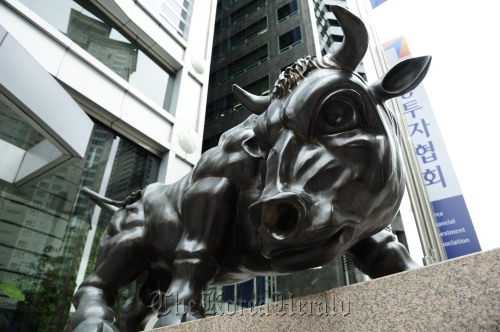“We have less room for input in some of Asia’s advanced trading bourses as they already have quality infrastructure. We do not have any long-term platform merges in our plan,” said Choi Tae-joo, head of International Relations at the Busan headquarters.
The KRX said on Wednesday that it will seek to attract more blue-chip foreign companies and sell its information technology systems to around 30 developing nations this year to raise its global profile and diverse revenue sources.
Its globalization program will also focuses on co-running of the Laos Securities Exchange it helped to build last year and similar works in Cambodia and Uzbekistan.
Korea’s involvement in the LSE dates to 2007 when the Bank of the Lao signed a memorandum of understanding with the KRX to develop a trading system and train its staff. It has similar agreements with Cambodia, Vietnam and Malaysia.
The plan is to continue focusing on providing information technology and securities market infrastructure to developing countries.
The Hong Kong Exchange, or the HKEx, emerged as the world’s champion bourse in raising money through initial public offerings thanks to the China pool it provides.
It has enjoyed synergy from allowing dual listings, in which foreign companies can raise funds through both HKEx and Shanghai Stock Exchanges. Market capitalization of HKEx, SSE and Shenzehn Stock Exchange combined totals $6.7 trillion, the world’s second largest after the U.S.
The annual trading volume of the HKEx and the Singapore Exchange in relation to total market capitalization was 83.7 percent and 67.3 percent, respectively, in 2010. The KRX, with an incredible 242.9 percent, was the world’s second-most liquid market only after the NASDAQ stock exchange. The KRX has market capitalization of just over $1 trillion.
“With the bullish market, it is doing well now. But it should be alarmed of all the merges and strategic alliances going on in the rest of Asia which would leave less pool of money for Seoul eventually,” Kim said.
Watchers say Hong Kong’s rise is unstoppable given the China pool it provides to foreign firms, but points to KRX’s lack of promotional activities.
“KRX’s hosting efforts lags behind that of its bigger rivals in Asia. It should try to list more foreign firms and form platform merges with other bourses in Northeast Asia,” Kim Jong-man, an economist at the Korea Institute of Finance said.
A total of 17 foreign companies, mostly Chinese, are listed on the country’s two stock boards, KOSPI and tech-heavy KOSDAQ. It now waits to list nine firms from the U.S., seven from Japan, 31 from China and one each from Britain, Thailand, Vietnam, Laos and Philippines, it said.
Japan, Asia’s second-largest stock market with market capitalization of about $4 trillion, is revamping its regulations to regain Asia’s top position.
The country has five stock exchanges, one of which is a future exchange and four that are commodity exchanges. It listed as many as 126 foreign firms in 1991 but now lists 27.
But three bourse operators, each regulated separately by the Financial Service Agency, economy ministry and agricultural ministry, are to form a merged exchange starting in 2013, a report by the FSA said.
“At this rate, Asia is going to have three major clusters of stock markets ― pan China, Japan, and Southeast Asia ― which would provide fewer and fewer opportunities for Korea to grow,” Kim said.
Singapore, where Asia’s second-biggest listed exchange operator sits, is pursuing its ambitious bid to merge with Australia’s stock exchange for $7.8 billion. The controversial bid currently faces strong oppositions from some members of Australian parliament but the deal, if successful, will make the world’s fifth-largest listed exchange group after Hong Kong, Chicago, Brazil and Germany.
“Exchange merges seem to come from the sense of crisis sweeping across the region as markets face limits in growing further ahead of other financial clusters,” Kim said.
The HKEx has market capitalization four times that of the Singapore Exchange and has monthly turnover five times larger than the SGX.
The SGX hopes to keep its brands but combine the strengths of the resource-rich Australian bourse with Singapore’s links to the booming China market.
“At the end of the day, this combination is not just about cost synergies. It’s really about strategically making us a much stronger exchange together, and positioning us to grow into Asia,” said SGX chief financial officer Seck Wai Kwong in a recent interview.
Singapore’s ambitious proposal sparked competitions even at an inter-regional level.
Canada’s Toronto Stock Exchange recently expressed hopes for strategic alliance or merge with the HKEx.
“When a combined platform by Malaysia, Singapore, Thailand and the Philippines start a trial run next year, this may be extended to a bigger bloc including Vietnam and Indonesia,” Kim said.
The KRX is currently in talks with South America, the Middle East and Central Asian countries such as Kazakhstan and Uzbekistan to help them provide infrastructure for their trading board.
By Cynthia J. Kim (
cynthiak@heraldcorp.com)








![[Today’s K-pop] Blackpink’s Jennie, Lisa invited to Coachella as solo acts](http://res.heraldm.com/phpwas/restmb_idxmake.php?idx=644&simg=/content/image/2024/11/21/20241121050099_0.jpg)